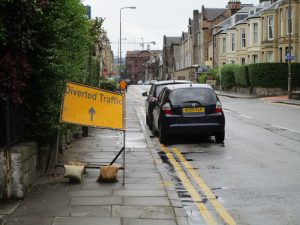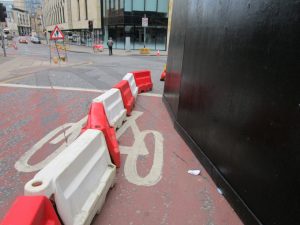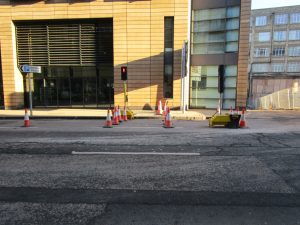Code of Practice on Street Works: key standards for pedestrians during roadworks
In 2014 the Scottish Government approved a Code which all bodies which carry out roadworks must follow – for example, councils fixing the road and utility companies laying or repairing cables and pipes. This statutory Code applies throughout Scotland (and the UK). A fundamental principle is that “You must take into account the needs of children, older people and disabled people, having particular regard for visually impaired [pedestrians].”
The Living Streets Edinburgh Group has prepared this briefing paper to help anyone wanting to campaign for a more walkable Edinburgh, by setting out some key requirements contained in the Code, and illustrating common failures to comply. For full details, see
Traffic signs

“Placing signs in the footway is permitted, but they must be positioned so as to minimise inconvenience or hazard to pedestrians, with particular consideration given to those with visual impairments, pushchairs, wheelchairs and mobility scooters. A minimum usable footway width of 1.5 metres should be maintained where possible…
Warning: In no circumstances must the footway width be reduced below 1.0 metres.” p16
Walking space

“If your work is going to obstruct a footway or part of a footway, you must provide a safe route for pedestrians… In general a minimum 1.2 metre width of walkway should be provided (this allows for a visually impaired person being guided), with an absolute minimum of 1 metre unobstructed width*. It is recommended that a wider walkway be provided if it can be done without resulting in a road closure or a reduction to shuttle working.
* It is not permitted for barrier feet or other equipment to obstruct this space.” pp 28-30
Ramps

“Where pedestrians are diverted to temporary walkways in the carriageway, suitable ramps must be provided to enable people using wheelchairs or pushchairs to negotiate kerbs safely. The layout should allow wheelchair and scooter users to enter and exit a temporary walkway safely.” p98
You can download this guide as a PDF here – Living Streets Edinburgh Roadworks Guide